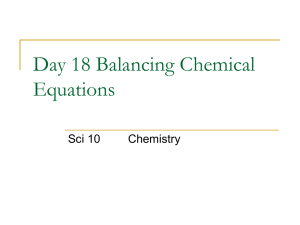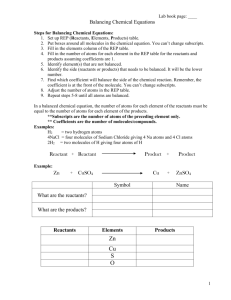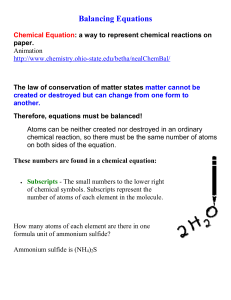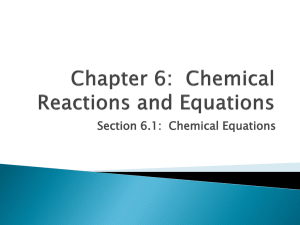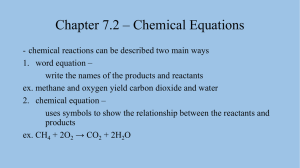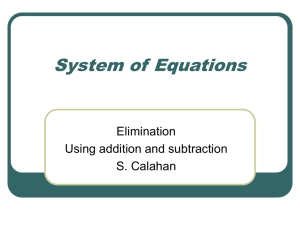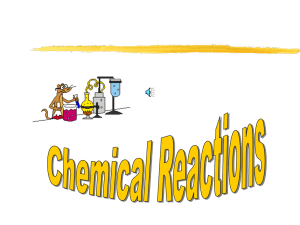Chapter 8.1 PPT
advertisement
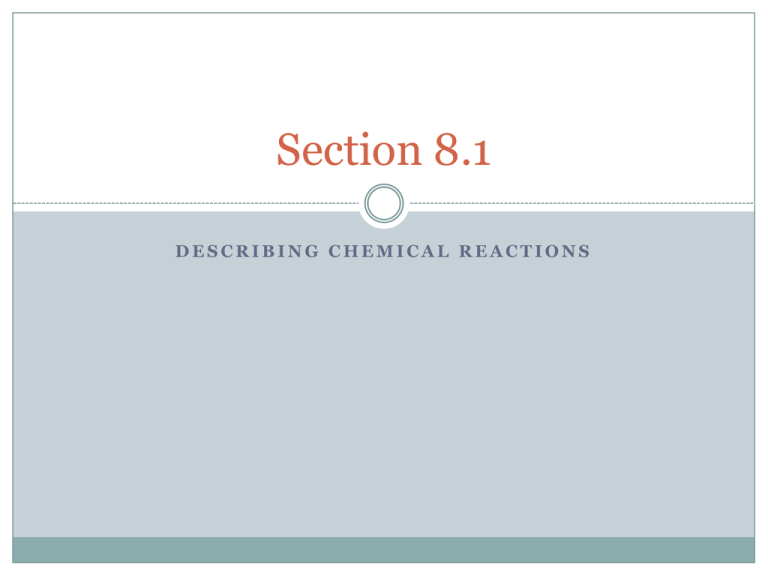
Section 8.1 DESCRIBING CHEMICAL REACTIONS Chemical Reactions A chemical reaction is the process by which one or more substances are changed into one or more different substances. In any chemical reaction, the original substances are known as the reactants and the resulting substances are known as the products. According to the law of conservation of mass, the total mass of reactants must equal the total mass of products for any given chemical reaction. Chemical Equations A chemical equation represents, with symbols and formulas, the identities and relative molecular or molar amounts of the reactants and products in a chemical reaction. example: The following chemical equation shows that the reactant ammonium dichromate yields the products nitrogen, chromium(III) oxide, and water. (NH4)2Cr2O7(s) → N2(g) + Cr2O3(s) + 4H2O(g) Chemical Equations Video Indications of a Chemical Reaction Certain easily observed changes usually indicate that a chemical reaction has occurred. Evolution of energy as heat and light Production of a gas Formation of a precipitate. A solid that is produced as a result of a chemical reaction in solution and that separates from the solution is known as a precipitate. Color change Signs of a Chemical Reaction Video Characteristics of a Chemical Equation The following requirements will aid you in writing and reading chemical equations correctly. The equation must represent known facts. The equation must contain the correct formulas for the reactants and products. The law of conservation of mass must be satisfied. A coefficient is a small whole number that appears in front of a formula in a chemical equation. Diatomic Elements Characteristics of Chemical Equations The first step in writing a chemical equation is to identify the facts to be represented. A word equation is an equation in which the reactants and products in a chemical reaction are represented by words. A word equation is qualitative example: methane and oxygen combine to yield carbon dioxide and water Characteristics of Chemical Equations The next step in writing a correct chemical equation is to replace the names of the reactants and products with appropriate symbols and formulas. A formula equation represents the reactants and products of a chemical reaction by their symbols or formulas. example: The formula equation for the reaction of methane and oxygen is CH4(g) + O2(g) → CO2(g) + H2O(g) (skeletal equation - not balanced) Reading a Chemical Equation Video Characteristics of Chemical Equations To complete the process of writing a correct equation, the law of conservation of mass must be taken into account. The relative amounts of reactants and products represented in the equation must be adjusted so that the numbers and types of atoms are the same on both sides of the equation. This process is called balancing an equation and is carried out by inserting and changing coefficients. ONLY coefficients can be changed in this process Balancing Chemical Equations by Inspection Balance the formula equation according to the law of conservation of mass. Balance the different types of atoms one at a time. First balance the atoms of elements that are combined and that appear only once on each side of the equation. Balance polyatomic ions that appear on both sides of the equation as single units. Balance H atoms and O atoms after atoms of all other elements have been balanced. If the coefficients do not represent the smallest possible wholenumber ratio of reactants and products, divide the coefficients by their greatest common factor in order to obtain the smallest possible whole-number coefficients. Balancing Chemical Equations by Inspection Video Characteristics of Chemical Equations To balance the equation, begin by counting atoms of elements that are combined with atoms of other elements and that appear only once on each side of the equation. CH4(g) + O2(g) →CO2(g) + 2H2O(g) (not balanced) Begin by counting carbon atoms. Carbon is already balanced in the equation. Two additional hydrogen atoms are needed on the right side of the equation. Characteristics of Chemical Equations CH4(g) + O2(g) → CO2(g) + 2H2O(g) (partially balanced) Now consider the number of oxygen atoms. Increase the number of oxygen atoms on the left side to four by placing the coefficient 2 in front of the molecular formula for oxygen. The correct chemical equation, or balanced formula equation, for the burning of methane in oxygen is: CH4(g) + 2O2(g) → CO2(g) + 2H2O(g) Methane Combustion Symbols in Chemical Equations Symbols in Chemical Equations Symbols in Chemical Equations Video Significance of a Chemical Equation Some of the quantitative information revealed by a chemical equation includes The coefficients of a chemical reaction indicate relative, not absolute, amounts of reactants and products. H2(g) + Cl2(g) → 2HCl(g) 1 molecule H2 : 1 molecule Cl2 : 2 molecules HCl 1 mole H2 : 1 mole Cl2 : 2 moles HCl This ratio shows the smallest possible relative amounts of the reaction’s reactants and products. Significance of a Chemical Equation The relative masses of the reactants and products of a chemical reaction can be determined from the reaction’s coefficients. An amount of an element or compound in moles can be converted to a mass in grams by multiplying by the appropriate molar mass. example: 1 m ol H2 2 .0 2 g H 2 m ol H2 2 .0 2 g H 2 Significance of a Chemical Equation The reverse reaction for a chemical equation has the same relative amounts of substances as the forward reaction. o An equation gives no indication of whether a reaction will actually occur. o Chemical equations give no information about the speed at which reactions occur. o Equations do not give any information about how the bonding between atoms or ions changes during the reaction. Interpreting a Chemical Reaction Interpreting a Chemical Reaction Video Practice Write word and balanced chemical equations for the following chemical reactions: • Hydrogen peroxide decomposes into water and oxygen. Practice Solid copper metal reacts with aqueous silver nitrate to produce solid silver metal and aquesous copper (II) nitrate Practice Solid calcium metal reacts with water to form aqueous calcium hydroxide and hydrogen gas Practice Nitrogen dioxide gas reacts with water to form aqueous nitric acid and nitrogen monoxide gas Practice Solid potassium chlorate decomposes to form solid potassium chloride and oxygen gas Practice Solid zinc metal reacts with aqueous copper (II) sulfate to produce solid copper metal and aqueous zinc sulfate. Practice Translate the following equations into sentences: 2 ZnO (s) + C (s) → 2 Zn (s) + CO2 (g) Practice Na2O (s) + 2 CO2 (g) + H2O (g) → 2 NaHCO3 (s) Practice Write a balanced chemical equation: Aqueous sulfuric acid reacts with barium chloride to produce barium sulfate precipitate and aqueous hydrochloric acid Practice Aluminum sulfate, an ingredient in anti-persperants is made by reacting solid aluminum oxide with aqueous sulfuric acid. In addition water is produced Practice The white paste lifeguards rub on their noses to prevent sunburn contains zinc oxide. Zinc oxide is made by reacting solid zinc sulfide with oxygen gas. Sulfur dioxide gas is also produced. Practice One of the most important uses of sulfuric acid is the production of phosphoric acid for use in fertilizers. Solid calcium phosphate is reacted with aqueous sulfuric acid to form phosphoric acid and solid calcium sulfate.
